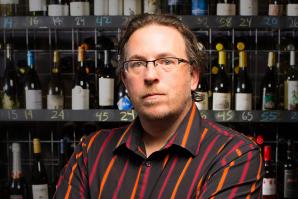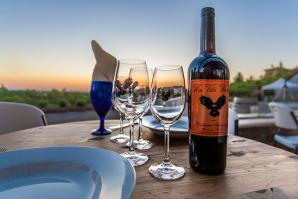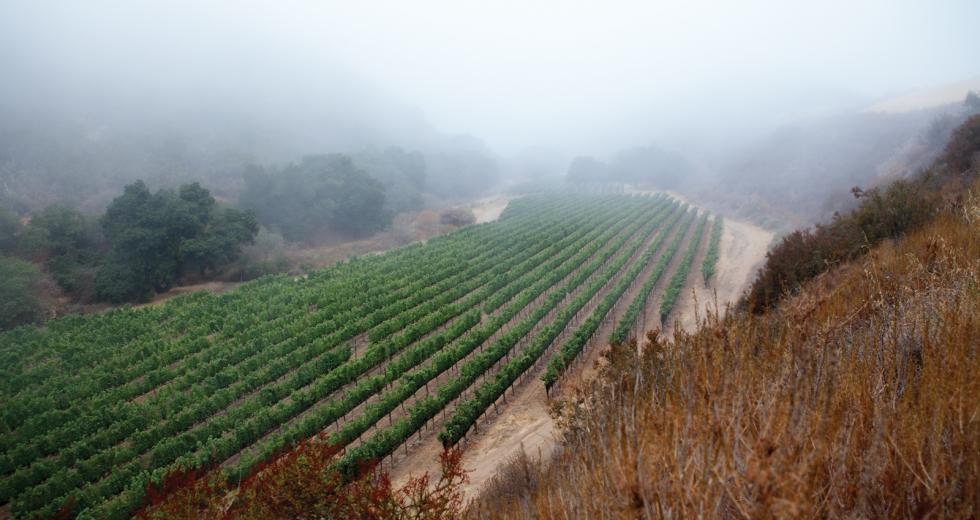On a late afternoon in the Caraccioli Cellars tasting room, the scrape of bar stools on the concrete floor signals the arrival of yet another couple exploring Monterey’s thriving wine scene.
They’ve left their son, daughter-in-law, two grandkids and dog for an evening alone in Carmel-by-the-Sea, and the female half of the couple announces cheerfully that they’re doing the Carmel Wine Walk. This is their third tasting room, and they’re eager to try the winery’s still and sparkling wines.
The couple doesn’t know it, but that’s music to the ears of the silver-blonde sitting quietly a few seats down the burnished wooden bar. She’s Monta Potter, CEO of the Carmel Chamber of Commerce, and one of the people who has helped harness the tourism potential of the region’s wine industry.
“It’s just taken off,” says Potter, who, like other locals, was thrilled when the region got a tip of the hat from Wine Enthusiast, coming in at No. 5 on the magazine’s “10 Best Wine Travel Destinations 2013,” beating out famous places like Napa and Sonoma. (Where did they rank, you ask? They didn’t make the cut.)
But staking a place on the wine map didn’t happen overnight for Monterey.
The region’s entry into the modern world of winemaking came in the 1960s following a UC Davis report that found Monterey County’s climate to be comparable with premium winegrowing regions like Napa and Burgundy.
But capitalizing on that resource took some figuring out.
“Monterey has always been a very interesting place. Unfortunately, it started like a lot of other places in California by planting the right grapes in the wrong places,” says Darrell Corti, president of the Sacramento-based Corti Brothers wine and food store.
It makes a big difference where you plant. The region is more than 80 miles long and has temperature variances of up to 40 degrees north-to-south on a typical summer day. Early efforts put sun-loving grapes like Cabernet Sauvignon in cooler areas, resulting in wines that had what’s often referred to as a “green” character, or the so-called “Monterey veggies,” Corti says.
Pioneers in the area included winemaking families like the Mirassous and Wentes, and Corti himself was part of that wave of development, serving as a partner in Monterey’s Chalone Vineyard from 1966 to ’69.
Not as hot as winegrowing regions like Amador but famous for its signature Zinfandels, Monterey keeps its cool courtesy of the bay’s “Blue Grand Canyon,” one of the world’s deepest marine canyons. Coastal influences also produce the significant day-to-night temperature swings that grapes desire. The soil is primarily loamy, unlike the decaying granite of regions like Amador and El Dorado, and although Chardonnay and Pinot Noir are the signature grapes, there’s more than 40 varietals planted here on almost 200 vineyards.
Monterey has “never stopped being the site of quite interesting wines,” Corti says. Notable new developments are the production of high-quality Pinot Noir — the notoriously difficult to grow red grape associated with France’s Burgundy region — along with lots of Chardonnay and “some very good Riesling.”
For consumers looking to explore Monterey wines there, choices range from crisp whites to Bordeaux-style red blends. The region boasts nine American Viticultural Areas (AVAs) (Monterey, the Santa Lucia Highlands, Arroyo Seco, San Lucas, Hames Valley, Chalone, Carmel Valley, San Antonio Valley and San Bernabe), and each district has a distinct growing climate. You only have to drive 15 scenic miles from Carmel to Carmel Valley to feel the proof — it’s sweater weather in Carmel and sweating weather in Carmel Valley, the kind of heat that grows good Cabernet Sauvignon and Merlot. Meanwhile, the east-facing vineyards growing on the Santa Lucia mountain range grow “absolutely terrific Pinot Noirs,” according to Corti.
Along with Chalone, well-known names in Monterey wine include Ventana Vineyards, J. Lohr Vineyards & Wines, Paraiso Vineyards, Hahn Estates and Estancia. Morgan Winery has a “terrific” unoaked (not barrel-aged) Pinot Gris, an up-and-coming varietal for the region, Corti says. And Miura Vineyards, a relative newcomer run by a UC Davis graduate and master sommelier Emmanuel Kemiji (who at one point worked for Corti Brothers) makes a sought-after Pinot Noir.
As a wine country getaway, Monterey has a long and glamorous history. Hollywood royalty has long made a beeline for the Central Coast. About three hours by car from Sacramento, the region is blessed with a breathtaking coastline, Old World charm, Pebble Beach and the renowned Monterey Bay Aquarium. As Scott Caraccioli, vice president of Caraccioli Cellars puts it, “It’s not a one-stop shop.”
But establishing the area as a wine destination has not been without hurdles. Unlike the Napa Valley, prettily knit together along scenic Highway 29 and the Silverado Trail, Monterey’s wine country is big and sprawling, and to get to quite a lot of it you have to drive down not very romantic sections of Highway 101.
To make the area more appealing, the Monterey County Vintners & Growers Association has developed free maps outlining suggested wine trails, including one that winds through the green folding hills of Carmel Valley and another that follows the River Road trail through the Santa Lucia Highlands. And for those who prefer to remain off the roads, plenty of wineries have opened neatly appointed tasting rooms in tourist-dense areas.
“There’s nine tasting rooms, 10 brands, that you can walk to in about four square blocks,” says Scott Caraccioli, vice president of Caraccioli Cellars, which uses highland Chardonnay and Pinot Noir grapes to make “fruit-forward” still and sparkling wines, including an elegant Brut.
Capitalizing on the appeal of strolling, swirling and sipping, local wineries and tourism officials put together a $65 “passport” good for $90 worth of tastings downtown. The passport doesn’t expire, so no pressure to do all the tasting rooms in a day. And wineries cooperate, sending visitors to each other — a key factor in its success, says Carrie Theis, a member of the Carmel-by-the-Sea City Council and owner of Hofsas House hotel in Carmel. Because the route is highly centralized with lots of stores, galleries and restaurants, the walk brings money to other businesses as well.
Funds raised from the proceeds go to the wineries and a part-time publicist who is overhauling the Carmel website. Hotels also have tie-ins to wine tourism. Hofsas House, for instance, offers a wine-and-cheese package in which guests are greeted with a bottle of wine and selection of cheese pairings from Carmel’s The Cheese Shop.
Because passports are only available locally, Potter’s been able to witness a side benefit: Buyers typically tend to skew a little younger than typical Carmel visitors, a demographic dividend for an area that is sometimes viewed as a bit of a gray-haired getaway. On a recent afternoon, she saw two bachelorette parties making the tasting rounds.
Along with the Carmel Wine Walk, there are tasting rooms in the city of Monterey and nearby Seaside as well as the large tasting center, A Taste of Monterey, on Cannery Row, the former street of sardine canning factories immortalized by John Steinbeck and now living out a second life as a popular lodging, dining and entertainment center. The Monterey County Vintners & Growers Association ties it all together with a “Three Perfect Days,” campaign, recommending visitors hit the in-town tasting rooms one day, drive the Carmel Valley the next and explore the vineyards of the River Road Trail on the third.
The growers’ association has worked to bolster its brand, sending out email blasts to people who register on the association’s website, keeping up traditional print advertising and maintaining a presence on Facebook and other social media.
The sip-and-trip approach, similar to the farm-to-fork food tourism being encouraged in the Sacramento area, dovetails with changes in the vacationing habits of Americans who now seem to crave a new experience, not just a change of scenery. “People want something to do, and they want kind of a prescribed something,” Potter says.
These days, there’s a lot of competition to provide those experiences, notes Theis, from hedonistically luxe getaways in Napa to the glitter and glare of Vegas. Having a thriving wine country in addition to Monterey’s other assets helps forge a connection to create that most important of tourism achievements: the repeat visit.
“When people come here, they love it,” she says. “But we have to remind them to come back.”
Recommended For You

The Wine on Miracle Mile
Sacramento sommelier Paul Marsh joins Stockton’s business renaissance
For the past 10 years, Paul Marsh has pledged himself to the pursuit of wine. In Chico, he learned the intricacies of its fruit by planting and harvesting a vineyard. With Kendall Jackson, he learned to sell. At The Firehouse Restaurant in Old Sacramento, he was educated on the finer points of building a wine collection in a hospitality setting, and he became a certified sommelier.

Wine Winner
How Dr. Grover Lee went from the pharmacy to the vineyard
Imagine you’re a successful businessman, but what you really want to be is a professional baseball player. You’re so sure of yourself that you begin spending nights and weekends studying and training as if Major League Baseball will soon be calling. And then they actually do, and at your first at-bat, you clear the bases.
That’s pretty much how things happened when Granite Bay pharmacist Dr. Grover Lee decided to become an award-winning winemaker.



